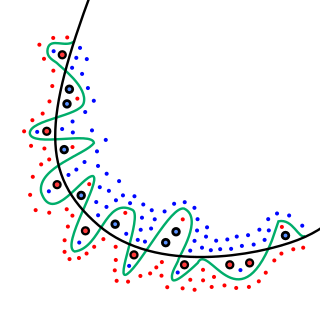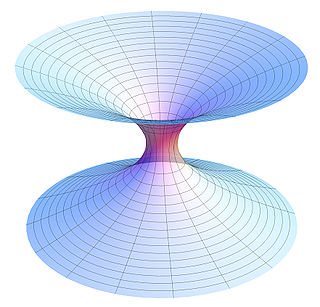Complexity characterises the behaviour of a system or model whose components interact in multiple ways and follow local rules, leading to non-linearity, randomness, collective dynamics, hierarchy, and emergence.
In philosophy, Occam's razor is the problem-solving principle that recommends searching for explanations constructed with the smallest possible set of elements. It is also known as the principle of parsimony or the law of parsimony. Attributed to William of Ockham, a 14th-century English philosopher and theologian, it is frequently cited as Entia non sunt multiplicanda praeter necessitatem, which translates as "Entities must not be multiplied beyond necessity", although Occam never used these exact words. Popularly, the principle is sometimes paraphrased as "The simplest explanation is usually the best one."
In computer science, brute-force search or exhaustive search, also known as generate and test, is a very general problem-solving technique and algorithmic paradigm that consists of systematically checking all possible candidates for whether or not each candidate satisfies the problem's statement.

In mathematical modeling, overfitting is "the production of an analysis that corresponds too closely or exactly to a particular set of data, and may therefore fail to fit to additional data or predict future observations reliably". An overfitted model is a mathematical model that contains more parameters than can be justified by the data. In a mathematical sense, these parameters represent the degree of a polynomial. The essence of overfitting is to have unknowingly extracted some of the residual variation as if that variation represented underlying model structure.

Simple living refers to practices that promote simplicity in one's lifestyle. Common practices of simple living include reducing the number of possessions one owns, depending less on technology and services, and spending less money. In addition to such external changes, simple living also reflects a person's mindset and values. Simple living practices can be seen in history, religion, art, and economics.

The Unix philosophy, originated by Ken Thompson, is a set of cultural norms and philosophical approaches to minimalist, modular software development. It is based on the experience of leading developers of the Unix operating system. Early Unix developers were important in bringing the concepts of modularity and reusability into software engineering practice, spawning a "software tools" movement. Over time, the leading developers of Unix established a set of cultural norms for developing software; these norms became as important and influential as the technology of Unix itself, and have been termed the "Unix philosophy."
Worse is better is a term conceived by Richard P. Gabriel in a 1989 essay to describe the dynamics of software acceptance. It refers to the argument that software quality does not necessarily increase with functionality: that there is a point where less functionality ("worse") is a preferable option ("better") in terms of practicality and usability. Software that is limited, but simple to use, may be more appealing to the user and market than the reverse.
Simplicity is the state or quality of being simple. Something easy to understand or explain seems simple, in contrast to something complicated. Alternatively, as Herbert A. Simon suggests, something is simple or complex depending on the way we choose to describe it. In some uses, the label "simplicity" can imply beauty, purity, or clarity. In other cases, the term may suggest a lack of nuance or complexity relative to what is required.
Minimum Description Length (MDL) is a model selection principle where the shortest description of the data is the best model. MDL methods learn through a data compression perspective and are sometimes described as mathematical applications of Occam's razor. The MDL principle can be extended to other forms of inductive inference and learning, for example to estimation and sequential prediction, without explicitly identifying a single model of the data.

In algorithmic information theory, algorithmic probability, also known as Solomonoff probability, is a mathematical method of assigning a prior probability to a given observation. It was invented by Ray Solomonoff in the 1960s. It is used in inductive inference theory and analyses of algorithms. In his general theory of inductive inference, Solomonoff uses the method together with Bayes' rule to obtain probabilities of prediction for an algorithm's future outputs.
Toothing was originally a hoax claim that Bluetooth-enabled mobile phones or PDAs were being used to arrange random sexual encounters, perpetrated as a prank on the media who reported it. The hoax was created by Ste Curran, then Editor at Large at the gaming magazine Edge, and ex-journalist Simon Byron. They based it on the two concepts dogging and bluejacking that were popular at the time. The creators started a forum in March 2004 where they wrote fake news articles about toothing with other members and then sent them off to well-known Internet-based news services. The point of the hoax was to "highlight how journalists are happy to believe something is true without necessarily checking the facts". Dozens of news organizations, including BBC News, Wired News, and The Independent thought the toothing story was real and printed it. On April 4, 2005, Curran and Byron admitted that the whole thing was a hoax. There have, however, been real Bluetooth dating devices since.
In physics and cosmology, the mathematical universe hypothesis (MUH), also known as the ultimate ensemble theory, is a speculative "theory of everything" (TOE) proposed by cosmologist Max Tegmark. According to the hypothesis, the universe is a mathematical object in and of itself. Tegmark extends this idea to hypothesize that all mathematical objects exist, which he describes as a form of Platonism or Modal realism.
Algorithmic information theory (AIT) is a branch of theoretical computer science that concerns itself with the relationship between computation and information of computably generated objects (as opposed to stochastically generated), such as strings or any other data structure. In other words, it is shown within algorithmic information theory that computational incompressibility "mimics" (except for a constant that only depends on the chosen universal programming language) the relations or inequalities found in information theory. According to Gregory Chaitin, it is "the result of putting Shannon's information theory and Turing's computability theory into a cocktail shaker and shaking vigorously."
Models of scientific inquiry have two functions: first, to provide a descriptive account of how scientific inquiry is carried out in practice, and second, to provide an explanatory account of why scientific inquiry succeeds as well as it appears to do in arriving at genuine knowledge. The philosopher Wesley C. Salmon described scientific inquiry:
The search for scientific knowledge ends far back into antiquity. At some point in the past, at least by the time of Aristotle, philosophers recognized that a fundamental distinction should be drawn between two kinds of scientific knowledge—roughly, knowledge that and knowledge why. It is one thing to know that each planet periodically reverses the direction of its motion with respect to the background of fixed stars; it is quite a different matter to know why. Knowledge of the former type is descriptive; knowledge of the latter type is explanatory. It is explanatory knowledge that provides scientific understanding of the world.
The Ultimate Boeing 747 gambit is a counter-argument to modern versions of the argument from design for the existence of God. It was introduced by Richard Dawkins in chapter 4 of his 2006 book The God Delusion, "Why there almost certainly is no God".
Simplexity is a neologism which proposes a possible complementary relationship between complexity and simplicity.

Overengineering is the act of designing a product or providing a solution to a problem that is complicated in a way that provides no value or could have been designed to be simpler.
In programming, the rule of least power is a design principle that "suggests choosing the least powerful [computer] language suitable for a given purpose". Stated alternatively, given a choice among computer languages, classes of which range from descriptive to procedural, the less procedural, more descriptive the language one chooses, the more one can do with the data stored in that language.

Botball is an educational robotics program that focuses on engaging middle and high school aged students in team-oriented robotics competitions. Thousands of children and young adults participate in the Botball program. It has been active since 1998 and features a robotics curriculum which focuses on designing, building and programming a pair of autonomous robots. Teams use a standardized kit of materials, document the process and then compete in a tournament in which the challenges change annually. All materials in the kits are exactly the same for every team around the world, so there are no unfair advantages. Botball teams are mostly based in the United States with over 300 teams and local tournaments in more than a dozen regions. In recent years it also holds an annual Global Conference on Educational Robotics (GCER), with an international tournament that attracts teams all over the country as well as from Mexico, Austria, China, Uganda, Poland, Qatar, Kuwait, Egypt, and many others.

Theoretical physics is a branch of physics that employs mathematical models and abstractions of physical objects and systems to rationalize, explain and predict natural phenomena. This is in contrast to experimental physics, which uses experimental tools to probe these phenomena.







